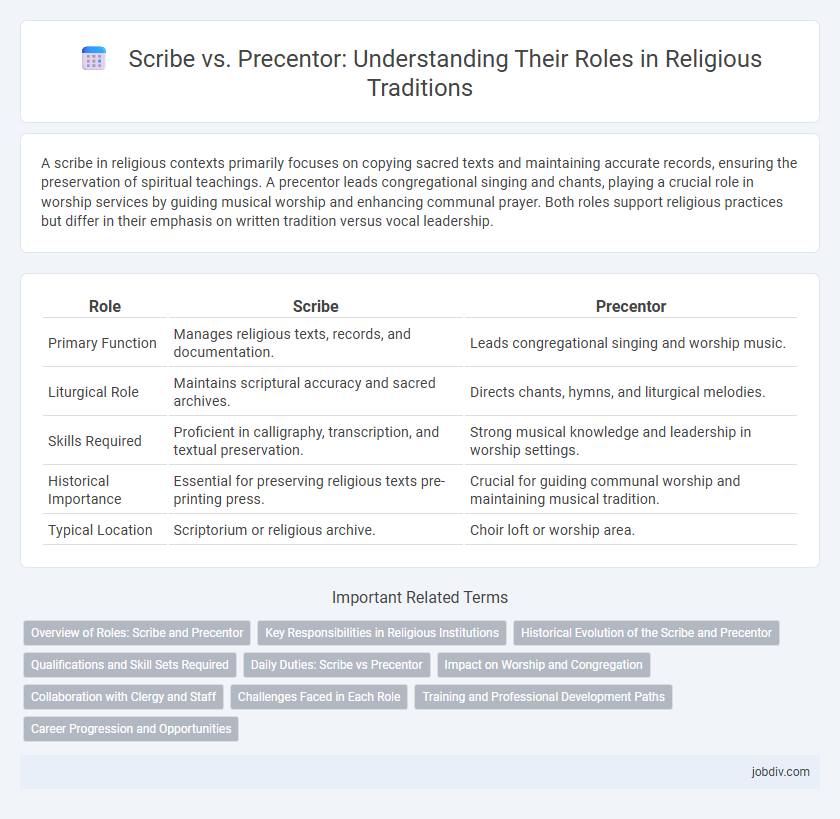A scribe in religious contexts primarily focuses on copying sacred texts and maintaining accurate records, ensuring the preservation of spiritual teachings. A precentor leads congregational singing and chants, playing a crucial role in worship services by guiding musical worship and enhancing communal prayer. Both roles support religious practices but differ in their emphasis on written tradition versus vocal leadership.
Table of Comparison
| Role | Scribe | Precentor |
|---|---|---|
| Primary Function | Manages religious texts, records, and documentation. | Leads congregational singing and worship music. |
| Liturgical Role | Maintains scriptural accuracy and sacred archives. | Directs chants, hymns, and liturgical melodies. |
| Skills Required | Proficient in calligraphy, transcription, and textual preservation. | Strong musical knowledge and leadership in worship settings. |
| Historical Importance | Essential for preserving religious texts pre-printing press. | Crucial for guiding communal worship and maintaining musical tradition. |
| Typical Location | Scriptorium or religious archive. | Choir loft or worship area. |
Overview of Roles: Scribe and Precentor
The scribe in religious contexts is primarily responsible for recording sacred texts, maintaining manuscripts, and ensuring the accuracy of written scriptures. The precentor leads congregational singing, chants liturgical music, and often oversees the musical aspects of worship services. Both roles are essential for preserving doctrinal integrity and enhancing communal worship experiences through written and musical traditions.
Key Responsibilities in Religious Institutions
Scribes in religious institutions are primarily responsible for meticulously copying sacred texts, maintaining archives, and preserving doctrinal accuracy, ensuring the transmission of religious knowledge across generations. Precentors lead congregational singing and chant, coordinating liturgical music and enhancing worship through skilled vocal leadership. Both roles are essential for maintaining the spiritual and ritual integrity of religious ceremonies, with scribes focusing on textual preservation and precentors on auditory worship coordination.
Historical Evolution of the Scribe and Precentor
The historical evolution of the scribe and precentor reflects their distinct yet complementary roles within religious institutions, where the scribe primarily managed manuscript transcription and record-keeping from ancient times through the medieval period. The precentor evolved as a key figure responsible for leading congregational singing and organizing liturgical chants, especially prominent in cathedral and monastic settings during the Middle Ages. Over centuries, the scribe's role diminished with the advent of printing, while the precentor's duties expanded alongside the development of complex liturgical music traditions.
Qualifications and Skill Sets Required
A scribe in religious contexts requires exceptional literacy skills, proficiency in ancient languages, and meticulous attention to detail for accurate transcription of sacred texts. The precentor must possess strong vocal abilities, musical knowledge, and leadership qualities to effectively lead congregational singing and chant during worship services. While scribes emphasize written precision and language expertise, precentors prioritize musical talent and the ability to inspire communal participation in liturgical settings.
Daily Duties: Scribe vs Precentor
The scribe is responsible for meticulously copying and preserving sacred texts, managing church records, and ensuring the accuracy of liturgical manuscripts, which requires precision and deep theological knowledge. The precentor leads daily worship by directing the choir, organizing hymns, and maintaining the musical order of services, fostering congregational participation and spiritual engagement. Both roles are vital for the smooth operation of religious ceremonies, with the scribe focusing on documentation and the precentor on musical and liturgical leadership.
Impact on Worship and Congregation
The scribe meticulously records sacred texts and liturgical instructions, ensuring accuracy and preservation of religious traditions that shape worship practices. The precentor leads congregational singing and psalmody, directly influencing the spiritual atmosphere and congregational participation. Together, these roles enhance the structure and engagement of worship, fostering a deeper communal connection to faith.
Collaboration with Clergy and Staff
The scribe and precentor collaborate closely with clergy and church staff to ensure smooth liturgical services and accurate record-keeping. The scribe documents important church activities, decisions, and sacraments, while the precentor leads worship through coordinated chants and hymns, enhancing congregational participation. Their combined efforts support both the administrative and spiritual functions of the church community.
Challenges Faced in Each Role
Scribes often face challenges in maintaining accurate records of sacred texts and liturgical instructions, requiring meticulous attention to detail to prevent errors that could alter religious doctrine. Precentors struggle with leading congregational worship, balancing the need to inspire participation while managing varying levels of musical ability and engagement within the choir. Both roles demand a deep understanding of religious traditions, with scribes focusing on preservation and precentors on active spiritual leadership.
Training and Professional Development Paths
Scribes in religious contexts are typically trained in meticulous manuscript copying and preservation, often through formal apprenticeship programs emphasizing scriptural accuracy and calligraphy skills. Precentors undergo specialized liturgical training, focusing on musical leadership, chant notation, and congregational direction, frequently receiving education at theological seminaries or music conservatories. Both roles demand ongoing professional development to maintain expertise in evolving liturgical practices and sacred texts.
Career Progression and Opportunities
The role of a scribe in religious settings traditionally involves meticulous documentation of sacred texts and administrative records, offering career progression through expertise in scriptural accuracy and church bureaucracy. Precentors focus on leading liturgical music and chanting, positioning themselves for advancement by refining musical leadership skills and enhancing worship experiences. Both paths provide unique opportunities for specialization, with scribes advancing in clerical administration and precentors in liturgical leadership within ecclesiastical hierarchies.
Scribe vs Precentor Infographic

 jobdiv.com
jobdiv.com